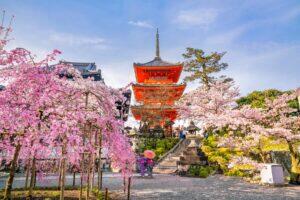Fodor's Expert Review Tenryu-ji Temple
Meaning "Temple of the Heavenly Dragon," this sacred spot is well named. In the 14th century, Emperor Go-Daigo, who had brought an end to the Kamakura shogunate, was forced from his throne by Takauji Ashikaga. After Go-Daigo died, Takauji had twinges of conscience. That's when Priest Muso Soseki had a dream in which a golden dragon rose from the nearby Oi-gawa. He told the shogun about his dream and interpreted it to mean the spirit of Go-Daigo was not at peace. Worried about this ill omen, Takauji completed Tenryu-ji in 1339 on the same spot where Go-Daigo had his favorite villa. Apparently the late emperor's spirit was appeased. Construction took several years and was partly financed by a trading mission to China, which brought back treasures of the Ming dynasty.
In the Hatto (Lecture Hall), where today's monks meditate, a huge "cloud dragon" is painted on the ceiling. The temple was often ravaged by fire, and the current buildings are as recent as 1900; the painting of the... READ MORE
Meaning "Temple of the Heavenly Dragon," this sacred spot is well named. In the 14th century, Emperor Go-Daigo, who had brought an end to the Kamakura shogunate, was forced from his throne by Takauji Ashikaga. After Go-Daigo died, Takauji had twinges of conscience. That's when Priest Muso Soseki had a dream in which a golden dragon rose from the nearby Oi-gawa. He told the shogun about his dream and interpreted it to mean the spirit of Go-Daigo was not at peace. Worried about this ill omen, Takauji completed Tenryu-ji in 1339 on the same spot where Go-Daigo had his favorite villa. Apparently the late emperor's spirit was appeased. Construction took several years and was partly financed by a trading mission to China, which brought back treasures of the Ming dynasty.
In the Hatto (Lecture Hall), where today's monks meditate, a huge "cloud dragon" is painted on the ceiling. The temple was often ravaged by fire, and the current buildings are as recent as 1900; the painting of the dragon was rendered by Shonen Suzuki, a 20th-century artist.
The Sogenchi garden, which dates from the 14th century, is one of Kyoto's most noteworthy gardens. Muso Soseki, an influential Zen monk and garden designer, created the garden to resemble Mt. Horai in China, the mythological home of the Immortals. It is famed for its arrangement of vertical stones embanking the large pond and as one of the first gardens to use "borrowed scenery," incorporating the mountains in the distance into the design of the garden. Now a UNESCO World Heritage site, the temple and its grounds are well attended by many admirers. There is also an excellent vegetarian Zen cuisine restaurant, Shigetsu, at the southern end of the temple grounds.
READ LESS







